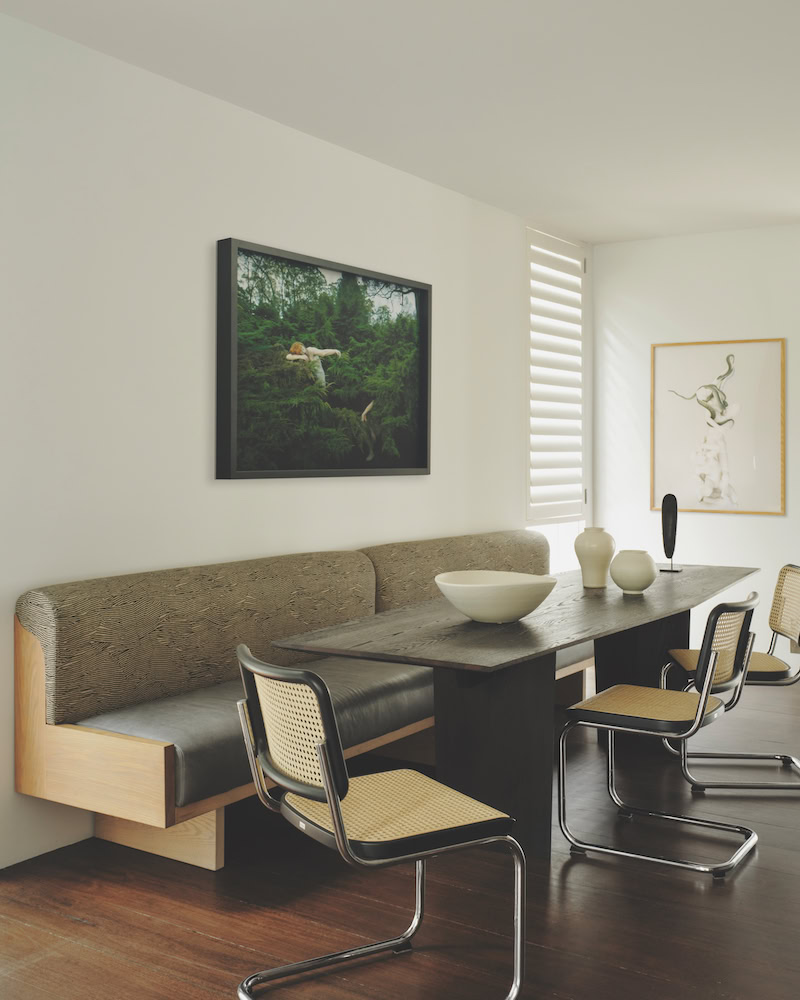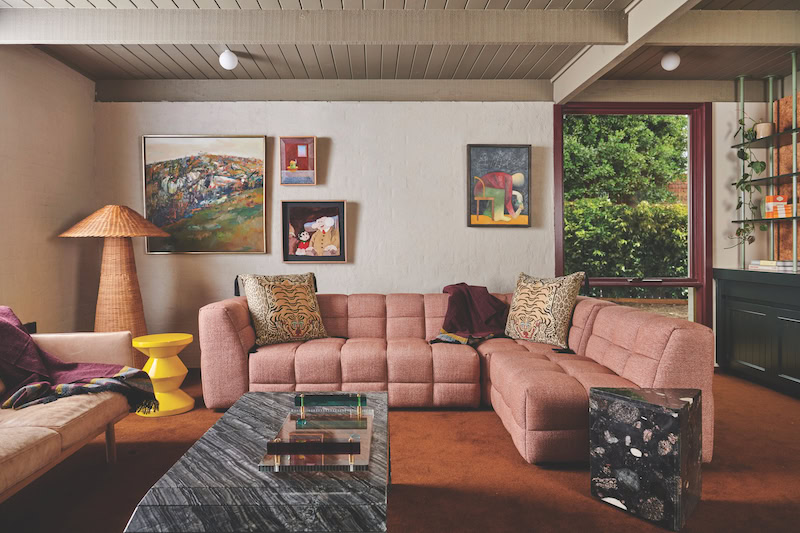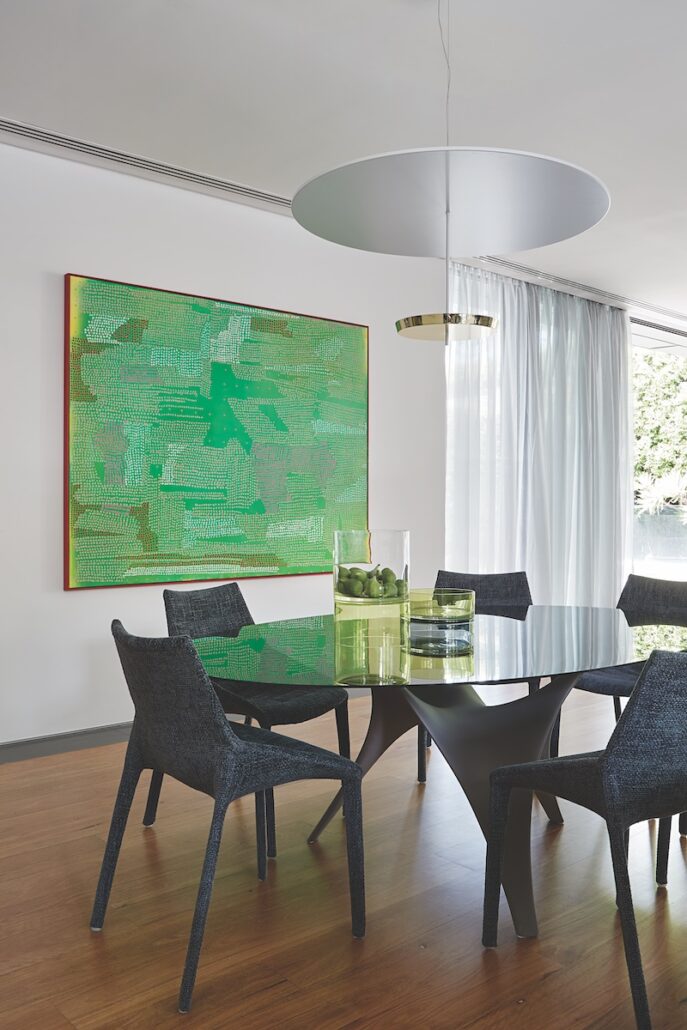When acquiring or curating new art, collectors and experts advise not to match your art to your sofa, curtains or existing pieces. So what should you consider in building a varied collection of artworks?
The consensus from these art and design experts is to embrace diversity, buy pieces that stir an emotional response and curate the art for the mood of the room.
Interior designer Amelda Wilde designed Foam House to create a boutique holiday accommodation in Torquay, Victoria drawing on notions of nostalgia and play to create a sense of escapism. The owners had an art collection they built over many years. Artworks varied in size, medium and expression with interesting aesthetics and intent, but the commonality was that pieces provoked a feeling in their owners. “Art is so deeply personal and an opportunity to be playful and visually express things that make you feel something. Warmth, intrigue, haunted, mystery – it could be a range of things, but for me, you have to feel something,” says Wilde.
She curated four artworks on the living room wall. At first glance, they are different styles and subjects, however there is harmony in their colour palette andAustralian identity. “These pieces are by local artists – Fraser Grant Fair, Cat Rabbit and Jiri Tibor Novak – and were selected for their colours and unpredictable relationship with one another,” says Wilde. The asymmetric and offset arrangement, with three artworks to the left and one to the right, reinforces that unpredictability and contributes to the relaxed, playful mood of the holiday house.
Like Wilde, designer and art consultant Swee Lim says, “The most important thing when buying and collecting is to ‘feel’ your art. It should lift your spirits or make you feel an emotion when you look at it.” Lim worked with the owners of Jade House to build a diverse collection that reflects a variety of cultures and styles, as they regularly travel overseas. “Diversity across art forms and subject matters brings interest, variety and richness into a home. You also want rooms to convey different moods and emotions through varied styles, mediums and sizes of artworks, and to think about how someone will be viewing a work,” says Lim.
She paired a contemporary figurative artwork by Rhys Lee with a small, textural artwork by Jacob Leary to infuse the living room with a romantic, feminine mood and give it a sense of luxury. The pairing of images also invites different perspectives of the artworks. With a broad view of the room, the undulating form of the pendant echoes the widebrimmed hat in Lee’s work, while the sculptural, three-dimensional detail of Leary’s artwork invites an up-close look. T
he artwork next to the dining table is different yet. The abstract emerald-toned work by Marisa Purcell injects the dining room and kitchen with uplifting colour, and its intricate detail is mesmerising, making it a restful piece to look at while dining or cooking.
“Embracing diversity encourages collectors to think critically about the connections and contrasts between different artworks. The key is to align it with the collector’s vision and preferences, whether that involves matching or embracing variety,” says Jack Milenkovic, creative director of Atelier Lab. Milenkovic collaborated with architecture studio Se Déa in curating artworks for Fletcher House in Tamarama, Sydney. Se Déa’s approach to the architecture and design provided a warm, casual home for the clients’ bold, edgy and vintage taste, and for eclectic artworks that evoke intrigue through their expression and display.
This is captured in the unexpected pairing and nontraditional hang of two artworks above the sideboard. The pieces, by Jordan Richardson and Stanislas Piechaczek, are different sizes and expressions, yet are of a similar subject and the juxtaposition amplifies the emotional response. “The offset placement and colour in the art create an unexpected moment and add playfulness within the room,” says Samantha Birtles, director of Se Déa.
The dining room has a softer, subtle ambience with two artworks, by Tamara Dean and Petrina Hicks. While being quite different artistic expressions, they are balanced through their harmonious palettes – green and light tones – and the sinuous forms and outstretched limbs of the subjects.
When it comes to acquiring art and building a collection, buying pieces that evoke a feeling is the most important aspect. Creativity and experimentation can follow in how you hang and curate your works and the feeling, mood and emotional response that can stir.
Above: A non-traditional hang evokes an emotional response with the unexpected pairing of works by Jordan Richardson and Stanislas Piechaczek. Photo: Cricket Saleh. Courtesy: Amelda Wilde Interior Design.

PHOTO: DAVE WHEELER. COURTESY:
SE DÉA AND ATELIER LAB.



